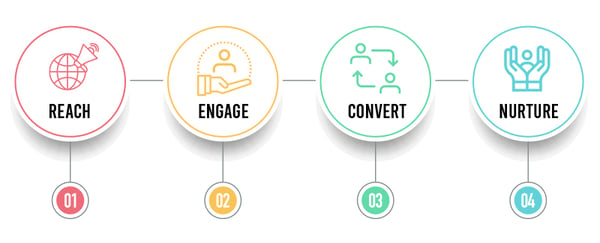
Of all the things that people do online, online shopping is one of the most popular. Sales through eCommerce have continued to rise with no sign of slowing down. Since the industry is only projected to increase in the coming years, it's clear that those who invest in creating online shops are making the right choice.
As an eCommerce store owner, it's important that you appeal to your target audience to rise above the vast amount of competition that you have. Understanding the eCommerce customer journey is a huge part of making sure this happens.
Read on to learn what this means, the stages of this journey, and how you can track and increase your shop's success!
What Is the eCommerce Customer Journey?
The "eCommerce customer journey" is a term used to refer to the stages of your customer's experience with your online business. The journey begins the moment that the customer learns about the product's existence and continues beyond the first time they make a purchase. The journey then continues assuming that you establish a relationship with the client and inspire brand loyalty.
This journey is important because it causes your customers to form opinions of your business. These opinions can be positive or negative and are based on their interactions with your eCommerce shop. If you view these interactions as a "journey" made of several stages, you can spend more time and effort perfecting each step. This will help you make the final entire journey better.
There are four main steps to the eCommerce customer journey. Each of these steps can be imagined as a gear in the larger machine. Each step should be considered the outcome of you solving a specific business challenge that eCommerce shops face. Mapping it out can help you build an effective strategy that will help your customers progress towards each succeeding stage with relative ease.

1. Reach
The "reach" stage involves attracting customers to your website. This can be organic or paid web traffic. Organic traffic consists of visitors who found your site on a search engine or linked on another site. Paid traffic refers to advertising.
There are several challenges involved in the reach stage of the journey. You might find that you're not getting enough web traffic. You can't bring people through the rest of the customer journey if you don't reach them in the first place.

To improve traffic (and therefore, reach), you should:
- Make sure your SEO is up to date. SEO (search engine optimization) is crucial. Most online shopping today begins with a Google search. A well-optimized website is more likely to appear higher in search results, leading to more traffic.
- Promote your business on social media. Facebook, Twitter, Instagram, and other platforms are packed with users who might be looking for products just like yours. Create a profile for your business and publish news and other content regularly. Interact with customers who contact you through your profiles. Promotion on social media doesn't need to include advertising, as your presence alone will help. But later, you can look into paid ads as well.
- Make sure your website is mobile-friendly. Most customers today shop on their smartphones or tablets. Any website that isn't compatible with these devices is going to miss out. Unfortunately, sites that look fantastic on desktop computers can be painful to navigate on a mobile device. The preferred method to make your site mobile-friendly is responsive design. Responsive websites alter their layout automatically depending on the visitor's device. Shift4Shop's eCommerce website templates are great examples of responsive design. Google also favors responsive sites, so you'll get a boost to your SEO.
- Publish content that will attract visitors. Most eCommerce shoppers are looking for a product that will help them solve a problem. Many are only doing research as they plan to shop at a later time. If you publish informative, valuable content on your website, visitors will take notice. This content can be detailed product pages and other information on your site. But most importantly, your site should have a blog. Post unique, useful articles that help customers solve their problems and learn more about your products. This will help with engagement as well (the next step in the customer journey).
2. Engage

Once visitors make it to your website, you need to engage them. This is the second stage of the eCommerce customer journey. Engagement involves the actions customers take on your website, and how they interact with it.
Just like reach, engagement has its challenges as well. Visitors might leave your site quickly ("bounce") or they might only look at a couple of pages. They may not add anything to their carts, or even make it to your products at all. They may find that, once they get to your website, they don't like it as much as they thought they would.
To engage your customers, you should:
- Improve the loading speed of your website. Internet users are notoriously impatient, especially online shoppers. Website visitors on mobile are an even tougher audience. If your site doesn't load within a few seconds, visitors are likely to bounce. Aim for as fast a load speed as possible so they'll give your site a chance. Unfortunately, your ability to improve load speeds can be limited by your technical knowledge. The eCommerce software you use can also either help or hinder your load speed. We'll discuss this a bit more in depth later.
- Encourage visitors to explore. How easily can customers browse your categories? Can they find the products they're looking for within a few clicks? Build a navigation structure that lets them view by category, manufacturer, new arrivals, or other filters. Make it easy and interesting for them to browse your site. If they arrive at your front page and don't know what to do next, you have a serious problem.
- Catch the customer's eye. Get visitor attention immediately with a rotating carousel banner on your site's front page. Make sure your other links are easy to spot — and ensure nothing looks like a link unless it is one. The last thing you want is for a visitor to be confused.
- Encourage customers to make a purchase. You want the shopping experience to be as easy as possible. Give customers information that will help them decide to buy. Showcase product reviews and Q&A sections on your product pages. List related products like accessories that a customer might want to add to their purchase. You can also provide a wish list feature for customers who aren't ready to buy just yet. Allow customers to save their cart for later if they so desire.
3. Convert
So you've engaged your customers — great! It's time to convert that engagement into doing actionable things that benefit your business. Usually this means making a purchase, but we'll cover more later.

Many businesses struggle with their conversion rates. Some shoppers might spend time on your site, but never buy anything. Other customers might place low-value orders, or abandon their cart altogether. Cart abandonment is a huge problem in eCommerce, with over 75% of carts never completing checkout. To improve conversions, you need to target all three of these issues. Visitors who never buy, customers with low order amounts, and abandoned carts.
To increase conversions, you should:
- Offer better prices. This isn't to say you should simply lower every price across the board. However, market research can tell you if you might be charging too much for some of your products. A permanent decrease in price might be warranted in this case. Otherwise, you can hold special promotions like limited-time sales, BOGO (buy one, get one free) deals, and more. Customers often get excited about big sales, and you can see a substantial increase in conversions during these events.
- Encourage larger orders. It can be hard to convince customers to add more to an order, especially if they're budget-conscious. But sometimes a customer just needs to be informed that they have more options. Related products come in handy again here, as do extras you can offer at checkout. A customer might be happy to add an accessory or product bundle to their order, as long as you make sure they see that it's available.
- Simplify the checkout process. Some customers abandon their cart if they find checkout to be too unwieldy. This is especially problematic on mobile devices, where the customer is trying to go through the process on a smaller screen. There are several ways to make checkout more convenient. You could offer a one-touch payment method like Apple Pay or other digital wallets. Another way to streamline checkout is to reduce the information the customer needs to enter, such as allowing them to check a box stating that their shipping and billing information are the same. You can also consider changing to a single-page checkout.
- Give the customer real-time shipping costs. "Shipping shock" refers to situations where a customer is about to place an order, but gets an unpleasant surprise in the form of unexpectedly high shipping costs. This is one of the leading causes of cart abandonment. Displaying accurate, real-time shipping rates will help avoid this. If your eCommerce platform supports it, you can even show the shipping cost in the customer's View Cart page. The point is to make it available to them before checkout, so it doesn't surprise them.
4. Nurture

You've reached out to customers, engaged them, and converted them. But the customer journey still isn't over. Now you need to nurture your relationship.
Many businesses have a problem with customers never returning. Others see too many guest checkouts (people who don't make accounts with you). Some struggle with a lack of reviews being posted online. These are all issues because they harm your ability to earn long-term customer loyalty. While new customers are always great, it's the existing customer base that will truly help you flourish.
The nurturing stage involves communicating with customers after their purchase. Your goal is to encourage them to remember your business. You want them to love your brand, and even become your advocate by recommending you to family and friends.
To nurture customer relationships, you should:
- Communicate with customers. Don't let the interaction end after thanking them for their order. Send a follow-up email later to request a product review (just make sure enough time has passed for them to use the product). Send another email later, with a coupon code, to encourage them to come back to your website. Create an email newsletter and allow customers to opt in to receive news about new products and upcoming promotions.
- Encourage customers to register on your website. While offering guest checkout can increase conversions, you still want customers to sign up. It's much easier to nurture relationships with registered users. You can offer incentives like a reward points-based loyalty program to make signing up more appealing. It also helps to let customers create an account at the end of the checkout process. Since they've already decided to buy from you at that point, they're more likely to decide to make an account to save the information they've already entered.
- Improve customer satisfaction. This is a big one, and takes a lot of attention. But if you put enough effort into satisfying your customers, it's the most effective way to gain loyalty, period. Your goal is to show your customers you care about them as individuals, rather than numbers. Keep communication open and provide customer service promptly. If you already have existing complaints from customers, you'll have a great starting point as to what you can improve. For example, you may need to review your return policy to ensure it's fair.
- Increase referrals to your business. Word-of-mouth advertising is extremely valuable, as people are more likely to trust recommendations from family and friends. It's also cost-effective, since customers are doing the work for you. Wish lists and gift certificates are great for helping spread the word, or you could take it further and create an affiliate program.
Now that we've covered the steps of the customer journey, let's take a closer look at some of the tools and techniques you can use to keep improving.

Metrics for Tracking Progress
In order to improve the customer journey for your clients, you will need to know what you're doing right vs what you should improve on. This will let you see what areas of your webpage need to be updated and changed. Your goal would be to make them more like the pages that get more clicks. To figure this out in a methodical way, you will need to track metrics on your website.
To track metrics, you will need a service like Google Analytics. This versatile software allows you to see complete information on your website and helps you connect this information with strategies to boost your ROI. You can see almost every part of the eCommerce customer journey on this platform.
Track Your Visitors
The first thing that you should look at is how many overall visitors your web page gets. You should look at the number of visitors, but also the ways that they found your site.
Did they find it on social media or from an inbound link that another website posted on their page? Did they find it via a Google search? What keywords did they enter into the search engine? This will help you understand your traffic and show you whether or not you need to invest in more social media services. It will also show you whether you should use different keywords on your page.

Recognize Your Bounce Rate
When you see the overall number of people visiting your site, you will want to assess how many of them are actually sticking around to look at your products. Load speed isn't everything: you still have a time limit for catching a visitor's attention. Since you only have about 15 seconds to engage your audience, a high bounce rate may indicate that you need to update your homepage or optimize your navigation system.
You also should look into what pages people usually look at before they choose to bounce. This will help you discover which of your products or other pages are less interesting to customers. You can make these a lower priority.
Look Into Conversions
Conversion rate is a metric that tracks the amount of time that someone does something productive after interacting with your off-page content. Basically, when someone interacts with an ad or free product listing that you have posted, it can be said to have "converted" if they take an action that you have previously defined as valuable to your business.
For eCommerce shops, this usually means making an online purchase. However, valuable action can also include following you on social media, contacting you via your landing page, or signing up for your shop's newsletter.
Discover Average Orders Per Customer
Because nurturing loyalty and drawing in repeat customers is an essential part of the eCommerce customer journey, it's important that you track the average amount of purchases that each person makes. You can do this without any external analytics software — simply check how many purchases were made by one customer account.
This will let you find out how good you are at customer retention. Because you can also track where the customers that make purchases found your page from (ads, social media, search engines, etc), you can figure out what marketing efforts have the greatest ROI.
How Can You Improve Your Customer's Experience?
 To improve your customer's experience, you will need to take specific action based on the metrics that you see. Each of the most important actions is done for the purpose of ensuring that each stage in the customer journey is positive and successful. Ultimately, this will inspire brand loyalty and increase your ROI.
To improve your customer's experience, you will need to take specific action based on the metrics that you see. Each of the most important actions is done for the purpose of ensuring that each stage in the customer journey is positive and successful. Ultimately, this will inspire brand loyalty and increase your ROI.
Perform Social Media Outreach (Reach)
One thing you can do to reach out to customers is to use social media appropriately. Since 3.8 billion people worldwide use social platforms like Facebook, Twitter, and Instagram, you will be more successful at engaging users here than anywhere else. Create a page on each of these platforms and upload information about your business to them. Make sure that you keep your DMs open so that customers can reach out and ask questions.
Use services like Facebook Ads to find the right audience. You will enter a budget and the demographics (age, gender, occupation) of your eCommerce shop's target audience. The PPC ad that you want to show off will be displayed to the most relevant users who will click it and be redirected to your website. On Twitter, you can pin properly tagged posts to get the word of your shop out there.
As for your page, keep it up-to-date. Like pages similar to yours without being your direct competitors to foster relationships with shops that might help promote your business. Post frequent images, videos, promotions, and links to your official website to remind your followers about your business frequently.
Create High-Quality, SEO-Optimized Content (Reach & Engage)

Search engine optimization (SEO) is the process of creating content to your page that's rich in high-traffic keywords and links to relevant websites. At the same time, populate your pages with relevant information. Initiate focused and insightful meetings with your customer-facing colleagues to know what your customers’ pain points are.
The goal of SEO is to make your page more appealing for search engine crawlers.
These crawlers will see keywords and associate you with relevant searches. They also will see the links to reputable sources that are incorporated in your post and believe you to be reputable as well. This leads to them boosting you to the top of Google.
Since 92% of people don't go past the first page in Google, this is a surefire way to reach your audience. It also segues them into the "engage" stage of the eCommerce customer journey because they can see engaging content the moment that they click on your site.
Enhance Your Website's Navigation (Engage)
We brushed on the idea of encouraging site exploration, but only as a vague concept. It can be achieved specifically by making sure that the page has a good navigation system. This means including sections for different types of products and tabs under each section so that each buyer can find exactly what they're looking for. It also means including a search bar for those who know exactly what they want (because they saw it on your site earlier.)
A good navigation page saves customers time and makes them less likely to get frustrated. This lowers your bounce rate substantially.
Ensure Fast Load Speeds (Engage)
Like poor navigation pages, slow-to-load sites are incredibly frustrating for consumers. Luckily, this can be easily fixed so that customers have the opportunity to further engage with your website. Combining files and minimizing HTTP requirements are two simple and highly effective ways to make your site load faster.

Don't Overlook Video Content (Engage & Convert)
Did you know that 73% of consumers are more likely to invest in a service after viewing a video about it?
Well, it's true. This means that video content isn't only essential to engagement- it's necessary for conversion. Embed videos showcasing new or popular products on the home page of your eCommerce shop. Make sure that you show these products from multiple angles and provide some facts and figures on how they're the best on the market.
You may also want to use animated infographics if you have numeric or textual data to showcase. This will be much more memorable to customers than simply reading a paragraph about your store.
Nurture Customer Relations Post-Purchasing (Nurture)
There are a variety of ways to ensure that customers get the most out of the 'nurture' stage of their journey. These strategies include:
- Encouraging customers to leave reviews
- Making those reviews visible on your website's home page
- Sending direct emails to your previous customers asking for feedback
- Sending those same customers coupon codes and exclusive promotions for future services
- Continuing to engage with old and new clients alike on social media
- Displaying PPC ads to those who have already shopped with you
This will help you nurture client relationships well into the future and inspire brand loyalty.
Start Engaging Consumers Today
Learning about the eCommerce customer journey is a crucial step in your growth as an online business owner. Let's recap:
- The eCommerce customer journey consists of 4 steps: Reach, Engage, Convert, and Nurture.
- Each of these steps describes a different set of goals.
- Reach is about growing traffic.
- Engage is about getting customers interested.
- Convert is about convincing them to buy.
- Nurture is about building loyalty.
- Each step in the customer journey also presents its own set of challenges.
- You can apply the guidance in this article to help meet these challenges.
- You can also use Google Analytics and other tools to give you the information you need.
- Always look for more creative and effective ways to improve the customer journey.
Shift4Shop includes a wide variety of tools to help you every step of the way, and you can get them all in our unlimited free eCommerce plan. However, keep in mind that the information in this article holds true no matter what software you use. The customer journey is a well-established aspect of eCommerce, and the better you understand it, the more successful your business can be.





Leave a reply or comment below